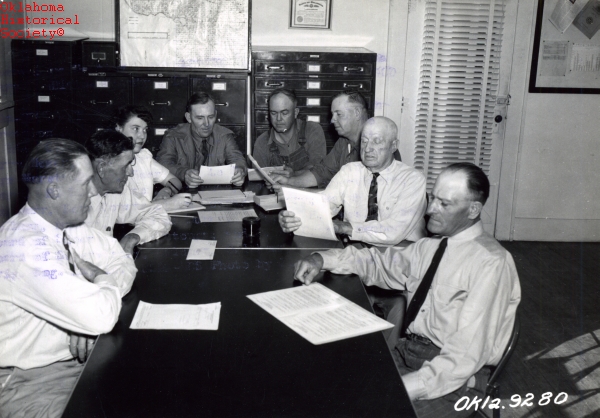
The Encyclopedia of Oklahoma History and Culture
CONSERVATION DISTRICTS.
With the passage of the Standard State Soil Conservation Districts Act of February 1937 the U.S. government strongly encouraged the states to pass laws providing for soil conservation in order to qualify for Soil Conservation Service (SCS) benefits. Accordingly, on April 15 of that year Oklahoma's governor, E. W. Marland, signed the Conservation District Enabling Act, authorizing the formation of conservation districts and the State Soil Conservation Committee. Further, the law required farmers to be involved in making conservation decisions. Thus the Soil Conservation Districts were born. Conservation districts and the secretary of agriculture signed a memorandum of understanding. SCS specialists transferred technology to farmers through the conservation districts.
On January 28, 1938, the McIntosh Soil Conservation District was the first district to be organized. In November 1938 the Arkansas-Verdigris Conservation District (now Tulsa County Conservation District) and Garvin Soil Conservation District became the first districts to begin program operations. At the end of the twentieth century there were eighty-eight conservation districts serving seventy-seven counties. The districts' official designation was changed in 1961 from Soil Conservation Districts to Soil and Water Conservation Districts and in 1971 to simply Conservation Districts. Nolen J. Fuqua (Duncan), president of the first Soil Conservation District Supervisors Association (1939–46) also served as president of the National Association of Conservation Districts (1955–59). On April 28, 1945, the State Soil Conservation Board replaced the State Soil Conservation Committee when the headquarters was moved to Oklahoma City. In 1970 the State Conservation Board was changed to the Oklahoma Conservation Commission.
Conservation Districts became sub-units of state government, partially funded by state appropriations to the five-member Oklahoma Conservation Commission. Five members serve on local district boards, with two members elected for two-year terms and three members elected for three-year terms. At the beginning of the twenty-first century districts involved themselves in a variety of natural-resource issues including soil and water conservation, flood control, urban and rural water quality projects, environmental education, and land reclamation.






